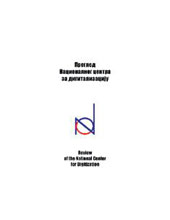Issues
Review of the National Center for Digitization
Publisher: Faculty of Mathematics, University of Belgrade
ISSN: 1820-0109
Issue: 27
Year: 2015

The Eternitas Web Application – Implementation Step of the Museum Information System of Serbia
Goran Gavrilović
Keywords: museum; museum information systems; databases; web applications; museum software; MISS; Eternitas; Serbia; western Balkans
1 - 12
Electronic Editions of Serbian Astronomical Institutions and Societies 2012-2013
Milan S. Dimitrijević and Jovan Aleksić
Keywords: astronomy; electronic publishing
13 - 17
The Digitization of the Documentary Sources and New Technologies in the Gallery of Matica Srpska
Tijana Palkovljević, Daniela Korolija Crkvenjakov, Snežana Mišić, Aljoša Petojević and Božana Grbić
Keywords: the Gallery of Matica srpska; digitization; artworks; documentation; exhibition; conservation; archives
18 - 26
A Virtual Tour of the Mediana Archeological Park Using Unity 3D Engine
Đorđe Manoilov, Nikola Gajić, Miloš Stošić and Dušan Tatić
Keywords: virtual tour; Unity; game engines; software implementation
27 - 34
Performance Analysis of Local and Distributed Rendering Methods for Preparing Video Contents
Nikola B. Gajić, Dušan B. Gajić and Radomir S. Stanković
Keywords: computer graphics and animation; distributed rendering; performance analysis.
35 - 42
Universal Mobile Cultural Heritage Guide Based on Android Technology
Dušan Tatić, Miloš Stošić, Đorđe Manoilov and Radomir Stanković
Keywords: handheld system; multimedia; augmented reality; tourist guide; cultural heritage
43 - 51
Linking Local Cultural Heritage Collections from the Slovenian - Italian Border Region With ICT
Špela Ledinek Lozej, Miha Peče and Barbara Ivančič Kutin
Keywords: cultural heritage; private collections; collecting; digital humanities; information and communications technology; digital repository; cross-border region; cross-border cooperation
52 - 64
Another Look on Digital Legacies
Nikolina Vukša Popović
Keywords: Omeka; digital legacies
65 - 71